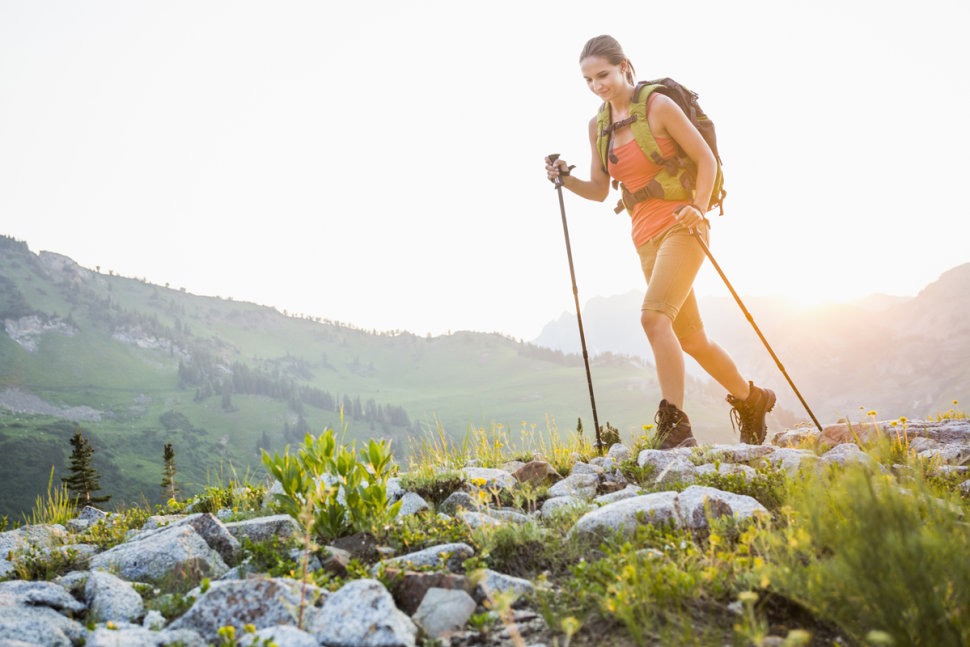
Nordic pole walking as compared to conventional walking when done properly, exercises 90 percent of your muscles. It’s low impact by nature, fun to do, and keeps you outdoors, making it an ideal form of exercise for anyone from out-of-season skiers to those recovering from injuries. Get started with this guide on gear, proper technique, and pole-walking location and workout suggestions.It has long been popular throughout Scandinavia and the U.K. Often used for cross-country ski training in the off-season, Nordic pole walking is a popular with people all over the world as a simple-yet-effective form of exercise.
Benefits of Nordic Pole Walking
Nordic pole walking uses both the lower and upper body muscles. The lower body gets the benefits of traditional walking or speed walking, and the poles work the upper body. Because of this combination, Nordic pole walkers benefit from fitness-building stimulation that’s not present in normal walking, as the chest, triceps, biceps, shoulders, and abdominals get a workout along with the leg muscles. The core is also engaged as the walker thrusts forward with the poles.Nordic pole walking improves cardio-respiratory fitness, especially in older adults for whom resistance training or high-impact sports are not ideal. It can also improve balance and reduce neck pain. It’s a total body workout that’s fun and that encourages a sense of adventure since it can be done everywhere from parks and roads to hiking trails.
Gear You’ll Need
Traditionally, pole walkers used fixed-length ski poles during the off-season to pole walk, staying in shape for Nordic skiing. While fixed-length poles can still be used, there is greater benefit from specially designed Nordic walking poles. Nordic walking poles come in two forms: one-piece, non-adjustable shaft versions available in varying lengths; and telescoping, adjustable-length, twist-locking versions. One-piece poles are generally stronger and lighter, but they must be matched to the user. Telescoping poles are “one-size fits all” and are more transportable.Choosing the best type of pole is highly personal; different models come with different types of hand grips and wrist straps. Most Nordic poles come with a rubber stopper over the tip so you can use them on pavement or sidewalks (walkers take the rubber off for better traction on dirt trails). On pavement, you’ll want the rubber tip, but on grass, dirt, or uneven terrain, you’ll have better traction with the metal tip.

The Technique
The first step when pole walking is to gather your gear. Before you depart on your walk, you’ll want to size up your poles: hold onto the grip, put the tip on the ground, and keep the pole vertical and your arm close to body; your elbow should be bent 90 degrees. Next, snap in: slide the straps over your wrists and grip the pole lightly.Now you’re ready to get going! Don’t overthink it: the cadence of your arms, legs, and body are like those used in normal, vigorous walking. But unlike walking, your stride is determined by the range of your arm movement – your stride will follow.
The longer the pole thrust, the longer the stride and the more powerful the swing of your pelvis and upper torso.Start by holding your poles lightly (don’t grip them too tightly). Walk with the poles alongside you moving in opposition to your legs. This sounds confusing, but it become natural to you: your left arm and right foot will move in tandem. Next, to check your form, strap on the poles if you haven’t already and let them drag behind you at about a 45-degree angle as you walk. Once the angle feels correct, grip the poles again and plant them on the ground instead of dragging them. You’ll still plant at that same 45-degree angle backward, with your elbows close to your body and your arms straight and relaxed. As you get comfortable with planting, add pushing.
Disclaimer
The Content is not intended to be a substitute for professional medical advice, diagnosis, or treatment. Always seek the advice of your physician or other qualified health provider with any questions you may have regarding a medical condition.



